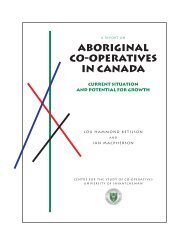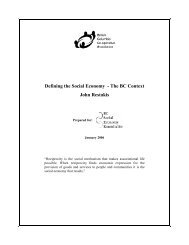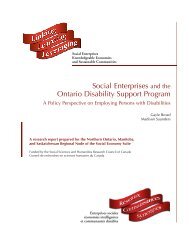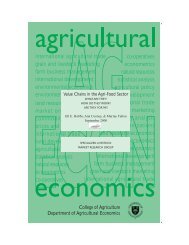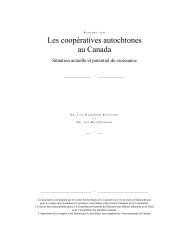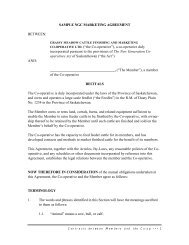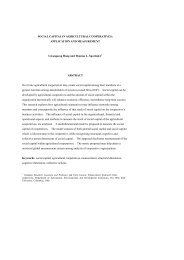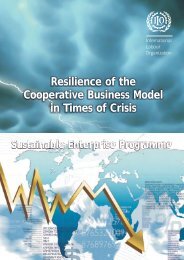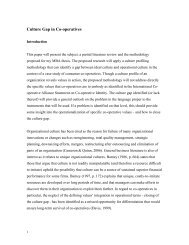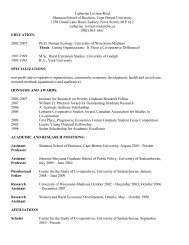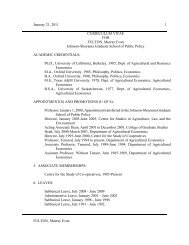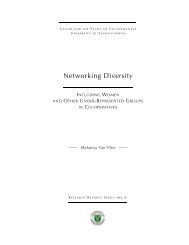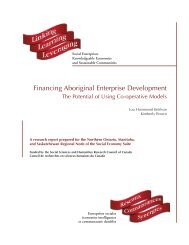Co-op College History - Centre for the Study of Co-operatives
Co-op College History - Centre for the Study of Co-operatives
Co-op College History - Centre for the Study of Co-operatives
You also want an ePaper? Increase the reach of your titles
YUMPU automatically turns print PDFs into web optimized ePapers that Google loves.
E VOLUTION OF THE C O - OPERATIVE C OLLEGE OF C ANADA 31<br />
placed, <strong>the</strong> <strong>the</strong>ory unfolds: new managers and directors did not have <strong>the</strong> same grasp <strong>of</strong> co-<strong>op</strong><br />
principles, ultimately placed less value on <strong>the</strong> education <strong>of</strong> employees (and members), and<br />
decided “by 1968 that <strong>the</strong>y could conduct <strong>the</strong>ir own training programmes at a better price.” 96<br />
This context within which <strong>the</strong> college evolved has been described as “a history <strong>of</strong> narrowing<br />
limits,” where decreasing support from <strong>the</strong> members was a symptom <strong>of</strong> <strong>the</strong> loss <strong>of</strong> knowledge<br />
and understanding <strong>for</strong> co-<strong>op</strong> philos<strong>op</strong>hy in <strong>the</strong> movement itself. 97<br />
Jake Siemens believed that an educational institute had to be autonomous and financially<br />
independent <strong>of</strong> <strong>the</strong> co-<strong>op</strong>erative movement. Yet <strong>the</strong> <strong>Co</strong>-<strong>op</strong> <strong>Co</strong>llege began as an educational<br />
institution directly funded by <strong>the</strong> movement, a dependency that meant <strong>the</strong> college<br />
was susceptible to <strong>the</strong> actions <strong>of</strong> member organizations. This financial uncertainty at <strong>the</strong> college<br />
shifted <strong>the</strong> balance between <strong>the</strong> two founding purposes: <strong>the</strong> college discovered that<br />
more income was derived from technical training than from <strong>the</strong> exploration <strong>of</strong> co-<strong>op</strong> <strong>the</strong>ory.<br />
This was one reason why it began its “<strong>op</strong>en-market approach” <strong>for</strong> funding (i.e., CIDA, <strong>the</strong><br />
Department <strong>of</strong> Indian and Nor<strong>the</strong>rn Affairs, and o<strong>the</strong>r federal grants). 98 The problem was<br />
directly related to financial dependence on member organizations. The fluctuation between<br />
two distinct approaches to co-<strong>op</strong> education pointed to <strong>the</strong> uncertainty within <strong>the</strong> co-<strong>op</strong><br />
movement as to what <strong>for</strong>m <strong>of</strong> education was preferred—and ultimately would be funded.<br />
Lacking strong affirmation <strong>for</strong> one particular approach, <strong>the</strong> college continued to struggle<br />
without a clear sense <strong>of</strong> purpose and with questionable solidarity with those in <strong>the</strong> larger co<strong>op</strong><br />
movement.<br />
The <strong>Co</strong>-<strong>op</strong>erative <strong>Co</strong>llege <strong>of</strong> Canada began as a vision that inspired thirty-five years <strong>of</strong><br />
instruction, research, publications, and conferences <strong>for</strong> pe<strong>op</strong>le within and outside <strong>of</strong> <strong>the</strong><br />
Canadian co-<strong>op</strong>erative movement. It was established to accomplish two purposes: to provide<br />
a successful standard <strong>of</strong> co-<strong>op</strong> business training and to inculcate <strong>the</strong> history and philos<strong>op</strong>hy<br />
<strong>of</strong> <strong>the</strong> co-<strong>op</strong>erative movement into every course. The inherent problem lay in maintaining a<br />
balance between <strong>the</strong>se two tasks while preserving, at <strong>the</strong> same time, institutional co-<strong>op</strong>erative<br />
support <strong>for</strong> both. The balance was determined by <strong>the</strong> college’s financial capacity, <strong>the</strong> dedicated<br />
work <strong>of</strong> employees, and <strong>the</strong> collaboration with its members. While cohesion among<br />
<strong>the</strong>se factors was sometimes tenuous, <strong>the</strong> volume <strong>of</strong> research, publications, and outreach<br />
programmes from <strong>the</strong> <strong>Co</strong>-<strong>op</strong> <strong>Co</strong>llege ultimately define <strong>the</strong> impact <strong>of</strong> its progress.<br />
<strong>Co</strong>ncerns that were evident to those struggling to promote education within <strong>the</strong> co-<strong>op</strong><br />
movement in 1955—<strong>the</strong> trend towards economic efficiency and <strong>the</strong> lack <strong>of</strong> member education—were<br />
<strong>the</strong> same concerns <strong>of</strong> leaders and educators in 1987, <strong>the</strong> year <strong>of</strong> <strong>the</strong> college’s<br />
demise. Even today, <strong>the</strong> education <strong>of</strong> new co-<strong>op</strong> members about co-<strong>op</strong> principles and practice<br />
is far from adequate; and while trends in rural dep<strong>op</strong>ulation continue, <strong>the</strong> possibilities<br />
<strong>for</strong> local, grassroots education initiatives to overcome this problem are more challenging<br />
than ever. In 1960, Alexander Laidlaw observed, “The false impression is somehow given that<br />
O CCASIONAL P APERS S ERIES #01–01




